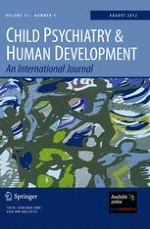01-08-2012 | Original Article
Characteristics of DSM-IV Attention Deficit Hyperactivity Disorder Combined and Predominantly Inattentive Subtypes in a Turkish Clinical Sample
Gepubliceerd in: Child Psychiatry & Human Development | Uitgave 4/2012
Log in om toegang te krijgenAbstract
Consecutively referred subjects (N = 537) to an outpatient clinic were evaluated to compare the Attention Deficit Hyperactivity Disorder Combined (ADHD-C) and predominantly inattentive (ADHD-PI) subtypes using parent and teacher ratings and neuropsychological variables. Statistical significance was at P < 0.002 adjusted for multiple comparisons. ADHD-PI subjects were older, more likely to be female, higher socioeconomic status, had lower Child Behavior Checklist and Teacher Report Form Aggression, Delinquency and Social Problems scores, and higher Withdrawal and Competence scores, compared to ADHD-C subjects. Comorbid conduct problems were more common among ADHD-C subjects. There were no differences in terms of anxiety/depression, and neuropsychological measures. The study is unique in that it provides data on a broad range of measures from a middle income developing country with important confirmation of similar pattern of differences and similarities between ADHD-C and ADHD-PI subtypes previously reported in North American and Western European samples.
